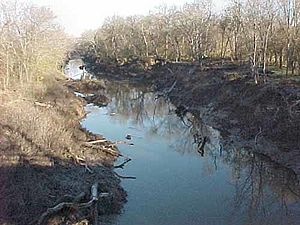Blue River (Oklahoma) facts for kids
Quick facts for kids Blue River |
|
|---|---|
| County | Murray |
| County | Pontotoc |
| County | Johnston |
| County | Bryan |
| Physical characteristics | |
| Main source | near Roff, Oklahoma |
| River mouth | Red River |
| Length | 141 miles (227 km) |
| Basin features | |
| River system | Red River |
| Basin size | 670 square miles (1,700 km2) |

The Blue River is a 141-mile (227 km) long river in southern Oklahoma, United States. It flows into the Red River. Through the Red River, its water eventually reaches the mighty Mississippi River. It was sometimes called 'Blue Creek,' but in 1977, its official name became 'Blue River.'
The upper part of the Blue River has clear water. This makes it a great place for fun outdoor activities, especially fishing! Parts of the river are protected by the state of Oklahoma and a group called the Nature Conservancy.
Contents
Where the Blue River Flows
The Blue River starts in southeastern Murray County. This is about 2 miles (3.2 km) southwest of a town called Roff. It then flows east into Pontotoc County. From there, it turns southeast, passing through Johnston and Bryan counties. It flows near the town of Milburn and within 3 miles (4.8 km) of Durant. Finally, it joins the Red River in southeastern Bryan County.
The river's basin, which is the area of land that drains into the river, is long and narrow. It covers about 670 square miles (1,750 km²). The upper part of the river is clear, fed by springs, and flows quickly. But the lower part of the river is deeper and can be muddy, especially after it rains.
A Free-Flowing River
The Blue River is special because it's one of the last "free-flowing" rivers in Oklahoma. This means there are no dams or other man-made structures controlling its water flow from where it starts to where it ends.
Fish in the River
The river is home to many kinds of fish. You can find different types of bass, like Smallmouth, Spotted, and Largemouth bass. There are also Crappie, Catfish, and various panfish. These include the Longear, Redbreast, Redear, and Green sunfish.
From November 1 to March 31, the Blue River is a special trout stream. This is because trout are added to the river at the Blue River Fishing Area near Tishomingo. Anglers (people who fish) come here to catch rainbow and brown trout during the colder winter months.
Protecting the Blue River
The upper part of the Blue River flows through an area called the Arbuckle Plains. This area has a lot of limestone, which means it has many springs and caves. Underneath this region is the Arbuckle-Simpson Aquifer. An aquifer is like a huge underground sponge that holds water. This aquifer is a very important source of drinking water for nearby cities and towns.
The Blue River gets its water from both rain runoff and these underground springs. The spring water is what makes the upper Blue River so clear. Most other rivers in this area are muddy. The upper Blue River has gentle rapids and small waterfalls. These are formed as the river cuts through limestone rocks.
Unique Plants and Forests
The soil in this area is shallow and rocky. This has prevented a lot of farming. Most of the land around the upper Blue River is still wild. It has open grasslands (prairie) and oak forests called Cross Timbers. Closer to the river, you'll find a different type of forest with oak, elm, hickory, and pecan trees.
The Blue River is also home to a rare plant called the Seaside alder. This plant is usually found only in coastal areas like Maryland and Delaware. It's very unusual to find it here in Oklahoma!
Conservation Efforts
Because the Blue River is so special, people are working to protect it. The Oklahoma Department of Wildlife Conservation owns about 3,367 acres (1,363 ha) along 9 km (5.6 miles) of the river. This area is open for fishing, hunting, and hiking.
Canoeing and kayaking are also popular on about 9.5 miles (15.3 km) of the river. This section has exciting rapids and drops over about 50 ledges and waterfalls. These drops range from 2 to 12 feet (0.6 to 3.7 meters) high. Floating is best in the winter and spring. In the summer, the river can be too low unless it has rained recently.
Protecting the Water Source
One of the biggest concerns for the Blue River is how much water is taken from the Arbuckle-Simpson Aquifer. This water is used by people in cities and towns. Sometimes, more water is taken out than can be naturally refilled by rain. This can reduce the flow of the river.
To help protect the aquifer and the land, the Nature Conservancy bought 490 acres (198 ha) of land along the river in 2011. This land is near Connerville. They named this protected area the Oka' Yanahli. In the Chickasaw language, this means "water flowing." This area was once home to the Chickasaw Indians in the 1800s.

